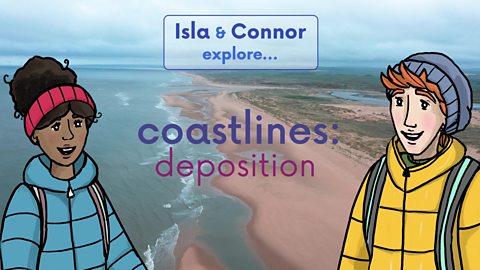Glaciated mountain erosion features
Glaciers are massive rivers of ice that move across land. They can change the landscape and create glacial features on mountains, like corries and ²¹°łĆŖ³Ł±šs.
In this article you can learn:
- What a glacier is
- How corries and ²¹°łĆŖ³Ł±šs are formed
- How a pyramidal peak is formed
- How to stay safe when climbing mountains
This resource is suitable for Landscapes topics for primary school learners.
Video - Features of glaciated erosion
Join Isla and Connor as they climb Ben Nevis and explore features of glaciated erosion: corries, ²¹°łĆŖ³Ł±šs and pyramidal peaks.
Watch this short video to find out about the features of glacial erosion.
ISLA: Are we really about to climb BEN NEVIS? Scotlandās highest mountain?
CONNOR: Yep! Canāt wait. Donāt worry - Iāve thought of everything.
Warm, waterproof clothes, high energy snacks and a drink, a whistle, a torch and a first aid kit. And look at this.
This is the route weāll take. Weāll walk the Mountain Track, which used to be a bridle path for ponies. Even though the track is well marked, our map and compass will help us find our way if it gets foggy or rainy.
And just for safety, Iāve told someone where weāre going, the path weāre taking and when we will be back.
ISLA: Great. It looks pretty clear and sunny down here right now, but we know the weather can change quickly when youāre on higher mountain slopes.
Itās already getting a bit colder! Thereās still snow on the upper slopes, look. I hear there are lots of glacial features to see here.
CONNOR: Yes, like corries, like that one over there.
A corrie is an armchair-shaped hollow found on the side of a mountain. This is where a glacier, a massive river of flowing ice, forms.
Glaciers form the corrie when more and more snow piles up. The snow gets squashed under its own weight and is compacted into hard ice.
The glacier gets so heavy that it begins to move downhill. Ice that has melted to water underneath helps the glacier to move.
The glacier erodes - wears away - the corrie in two ways. āPluckingā steepens the back wall of the corrie, while āabrasionā deepens the hollow.
Corries like this were formed during the ice age, which was at its peak about 22,000 years ago.
ISLA: Wow, doesnāt the River Tay start in a corrie at the top of Ben Lui?
CONNOR: Yes! And corries can form another kind of glacial feature called an ²¹°łĆŖ³Ł±š.
ISLA: Oh thereās a famous one on Ben Nevis isnāt there? The CĆ rn MĆ²r Dearg “”°łĆŖ³Ł±š.
Thatās it! When two corries form back to back, a steep ridge, called an ²¹°łĆŖ³Ł±š, forms between them.
Ben Nevis is the home of lots of tricky mountain scrambles where people climb these steep ridges. In the summer they do it by rock climbing, in the winter you need ice axes an special spikes on your feet called crampons.
CONNOR: It would definitely be hard to scramble along that!
ISLA: Hooray! We made it! To the top of the mountain - what a view!
CONNOR: How does it feel to be on the peak, standing on top of millions of years of landscape changes?
ISLA: Itās incredible. Speaking of peaksā¦ weāre standing on a pyramidal peak. Remember how an ²¹°łĆŖ³Ł±š forms between two corries?
When three of more corries erode the mountain back to back, the ridges form a pyramidal peak - that classic mountain shape we all think of!
CONNOR: Wow, mountains change shape a lot more than we realise. Iām pretty chuffed that weāve bagged a Munro, Isla.
ISLA: Bagged a Munro?
CONNOR: Yeah, a Munro is a Scottish mountain that has an elevation of more than 3000 feet - 914 metres. Weāre 4413 feet above sea level here! On top of the world!
ISLA: So which Munro are we bagging next? Cairngorm?
CONNOR: Ben Macdui?
ISLA: Liathach?
CONNOR: Bring it on!
What is a glacier?
- A glacier is a huge mass of ice that moves slowly across land.
- A glacier needs very cold temperatures and lots of snow to form.
- Air temperature gets lower the higher up you are from sea levelThe average level of the sea's surface.. That's why you can often see snow on mountain tops.
- Glaciers usually form high up on mountains because the temperature is much lower.
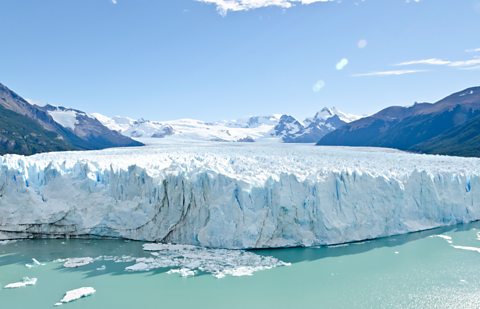
Glaciers in Scotland
During the last the Ice AgeA long period of time when the Earth's temperature became very low. The Earth's surface was buried under sheets of ice. It was at its peak about 22,000 years ago., Scotland was often covered in glacierA massive river of slow moving ice.. They formed high on mountains and flowed downhill. Now the glaciers have gone we can see how they shaped the mountains, forming corries, ²¹°łĆŖ³Ł±š and pyramidal peaks.
What is a corrie?
- A corrie is an armchair-shaped hollow found on the side of a mountain. It is the place where a glacierA massive river of slow moving ice. once formed.
- Most corries were formed during the Ice AgeA long period of time when the Earth's temperature became very low. The Earth's surface was buried under sheets of ice. It was at its peak about 22,000 years ago..
- Snowflakes collect in a hollow. As more snow falls, the snow gets squashed (compressed) and air is squeezed out.
- Over thousands of years, the compacted snow becomes hard glacier ice.
- The hard glacier ice gets so heavy that it begins to move downhill. Ice that has melted into water underneath helps the glacier to move.
- Eventually, the moving glacier erosionWearing away over time. the surface of the corrie. This is glaciated erosion.
Glaciated erosion takes place in two ways:
- Plucking steepens the back wall of the corrie.
- Abrasion deepens the hollow of the corrie.
What happens when corries form back-to-back?
- When two corries form back-to-back, a steep ridge called an ²¹°łĆŖ³Ł±š is created.
- When three or more corries erode a mountain back-to-back, the ²¹°łĆŖ³Ł±šs form a pyramidal peak. This is the classic mountain shape that looks like a pyramid.
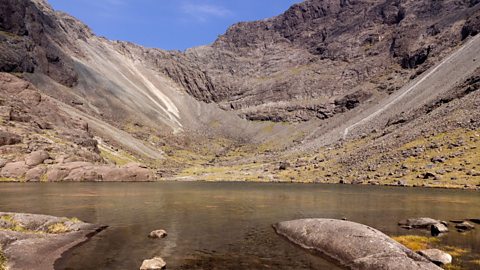
Image caption, Corrie
A corrie is a large hollow on the side of a mountain. A glacier often forms in a hollow and over time the glacier erodes the mountain, making the hollow bigger and forming a corrie. This corrie can be found high in the Black Cuillin mountains on the Isle of Skye. (Photimageon / Alamy Stock Photo)
Image caption, “”°łĆŖ³Ł±š
An ²¹°łĆŖ³Ł±š is a steep ridge that is created when two corries form back-to-back. Many mountain climbers like to scramble along these steep ridges, like the CĆ rn MĆ²r Dearg “”°łĆŖ³Ł±š. (Tim Geach / Alamy Stock Photo)
Image caption, Pyramidal peak
When three or more corries erode a mountain back-to-back, the steep ²¹°łĆŖ³Ł±šs create a pyramidal peak. This is the classic mountain shape, like the peak of Buachaille Etive MĆ²r in the Highlands. (David Dennis / Alamy Stock Photo)
1 of 3

Key words about glaciated mountain erosion
- glacier - A massive river of slow moving ice.
- glacial features - Landscape features that have formed by glaciers.
- corrie - An armchair shaped hollow found on the side of a mountain. This is where a glacier once formed.
- ²¹°łĆŖ³Ł±š - A steep ridge created when two corries form back-to-back.
- pyamidal peak - When three or more corries erode a mountain back-to-back, ridges (²¹°łĆŖ³Ł±šs) form a pyramidal peak. This is the classic mountain shape that looks like a pyramid.
- compact - When two or more objects are closely packed together and there's no space between them. For example, snow can become compacted so there is no room for air between the snowflakes.
- erosion - Wearing away.
- plucking - When rocks and stones become frozen to the bottom or the sides of a glacier. The rocks and stones are plucked from the ground or rock face as the glacier moves. Plucking leaves behind a jagged landscape.
- abrasion - When rocks and stones become stuck to the bottom and sides of a glacier. The rocks and stones rub against the bedrock (at the bottom of the glacier) and rock faces (at the sides of the glacier) as the glacier moves.
- The Ice Age - A long period of time when the Earth's temperature became very low. The Earth's surface was buried under sheets of ice. It was at its peak about 22,000 years ago.
- munro - A Scottish mountain that is over 3000 feet (914 metres) high.
Mountain climbing safety
In the video at the top of the page, Isla and Connor climbed Ben Nevis to explore features of glacial erosion.
Mountain climbing can be very dangerous and you should never try it on your own. Always make sure you have a responsible adult who has climbing experience with you.
You should always tell someone:
- Where you are going
- The path you are taking
- When you expect to be back
Remember to bring:
- Warm waterproof clothes
- High energy snacks and a drink
- A whistle
- A torch
- A first aid kit
- A map
- A compass
Find out more:
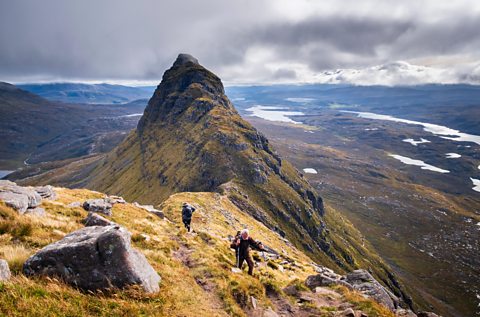
Test your knowledge
Quiz
Challenge

Design your own 3D mountain.
Use your art and design skills to create a 3D mountain peak. Can you include some glacial features, like corries and ²¹°łĆŖ³Ł±šs, in your design?
Think about what kind of materials you will need.
Here are some guides to help you with design techniques using paper: Design techniques: Paper cutting
More on Landscapes
Find out more by working through a topic
- count15 of 25

- count16 of 25

- count17 of 25
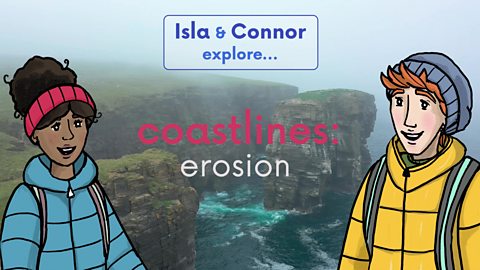
- count18 of 25
